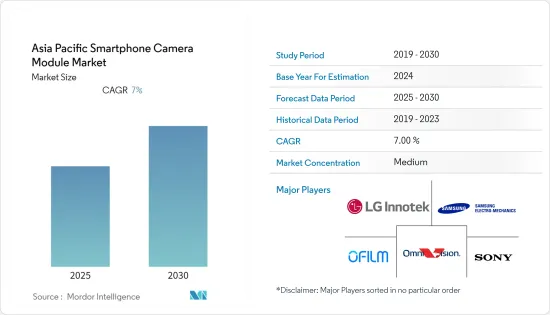
|
시장보고서
상품코드
1631612
아시아태평양의 스마트폰용 카메라 모듈 : 시장 점유율 분석, 산업 동향 및 통계, 성장 예측(2025-2030년)Asia Pacific Smartphone Camera Module - Market Share Analysis, Industry Trends & Statistics, Growth Forecasts (2025 - 2030) |
||||||
아시아태평양의 스마트폰용 카메라 모듈 시장은 예측 기간 동안 CAGR 7%를 기록할 것으로 예상됩니다.

주요 하이라이트
- 스마트폰용 카메라 모듈은 디지털 스틸 카메라(DSC) 시장을 파괴했습니다. 카메라 모듈의 성능과 복잡성이 크게 향상되어 컴팩트 카메라의 판매가 감소하고 있습니다. 듀얼 카메라 및 3D 센싱 카메라는 기존 소형(또는 CMOS) 카메라 모듈(CCM) 기술을 구현하는 새로운 방법이며, 시스템당 카메라 수를 증가시켜 성장을 유지할 수 있습니다.
- 아시아태평양의 스마트폰용 카메라 모듈 시장을 주도하는 요인 중 하나는 스마트폰 1대당 카메라 수(대수)의 증가입니다. 스마트폰에서 생성되는 이미지의 기능성과 품질을 향상시키기 위해 그리고 전면 카메라의 증가 추세에 따라 OEM은 단일 후면 카메라에서 듀얼, 트리플, 쿼드 카메라 설계로 전환하고 있으며, 그 결과 스마트폰 1대당 평균 카메라 모듈의 채택이 증가하고 있습니다. 채택이 증가하고 있습니다.
- 예를 들어, photonicsViews의 통계에 따르면, 듀얼 전면 카메라와 듀얼 후면 카메라의 도입으로 스마트폰 1대당 카메라 수가 증가하여 2022년에는 평균 2.7대가 될 것으로 예상됩니다.
- 스마트폰의 카메라는 실내나 야간에도 고화질, 고해상도 사진 및 동영상, 광학식 손떨림 보정, 줌 기능, 고속 오토포커스 등을 제공할 것으로 기대되고 있습니다. 또한, 기존 카메라에서는 센서 크기가 화질을 결정하는 중요한 요소였으나, 스마트폰에서도 마찬가지다. 이러한 추세에 따라 각 스마트폰 업체들은 독자적인 기능을 갖춘 특정 이미지 센서 개발에 적극 나서고 있습니다.
- COVID-19 사태로 인한 소비자의 소비 행태 변화와 스마트폰 시장이 포화상태에 가까워지면서 2020년 스마트폰 판매량 둔화를 목격할 수 있었습니다.
아시아태평양의 스마트폰용 카메라 모듈 시장 동향
첨단 카메라 기술 도입이 시장을 주도할 것으로 예상됩니다.
- 휴대폰이 진화함에 따라 소비자의 요구도 진화하고 있습니다. 이에 따라 기술 발전과 연구가 추진되어 인공지능, 초고속 충전, 베젤리스 디스플레이, 전동 카메라 등의 개발이 이루어졌습니다.
- 스마트폰 카메라의 발전은 단순히 카메라의 수와 메가픽셀의 증가에 그치지 않았습니다. 스마트폰 제조사들은 혁신을 거듭하여 잠망경 기반 시스템을 도입하여 이 분야의 획기적인 기술 혁신의 최신 사례를 선보였습니다. 이를 통해 스마트폰 카메라는 화질을 희생하지 않고도 모터 구동 내부 광학 시스템을 통해 고급 광학 10배 줌을 구현할 수 있게 되었습니다. 이러한 기술 혁신은 향후 몇 년 동안 소비자들이 구매를 고려할 때 차별화 요소로 작용할 것으로 보입니다. 예를 들어, 2020년 Oppo Find X2 Pro, 삼성 Galaxy S20 Ultra, Realme X3 SuperZoom은 모두 잠망경 줌을 탑재했고, 2021년 S21 Ultra는 카메라 배치를 변경하여 잠망경과 기존 두 종류의 줌을 탑재하여 줌의 품질을 향상시켰습니다. 줌의 품질을 향상시켰습니다.
- 카메라 센서의 발전과 함께 스마트폰에 전용 영상 신호 처리 프로세서를 내장하는 수요가 증가하고 있습니다. 화질과 편의 기능 측면에서 스마트폰 카메라 기술의 가능성은 점점 더 넓어지고 있습니다. 전용 영상신호처리 프로세서는 일반적인 생각과 달리 단순히 고속 영상처리만을 위한 것이 아닙니다. 화질을 향상시키고, 노이즈를 줄이고, HDR, 자동 노출, 자동 초점, 자동 화이트 밸런스 등의 기능을 강화합니다.
- 예를 들어, Spectra 580 CV-ISP가 탑재된 퀄컴의 새로운 Snapdragon 플랫폼은 초당 2.7기가 픽셀을 처리할 수 있는 트리플 이미지 신호 프로세서(트리플 ISP)를 갖추고 있어 기기에서 최대 3대의 개별 카메라를 동시에 사용할 수 있습니다. 동시에 사용할 수 있습니다. 이 기능은 세 개의 서로 다른 카메라 간의 원활한 줌, 3장의 동시 이미지 캡처(각각 최대 28MP), 멀티 캡처 HDR 합성, 전면 비디오 영상을 후면 비디오 영상에 겹쳐서 촬영하는 등 다양한 가능성을 열어줍니다. 퀄컴의 트리플 ISP 지원 단말기에서는 최대 3개의 4K HDR 영화를 동시에 촬영할 수도 있습니다.
- 스마트폰 카메라의 기능은 진화하고 있습니다. 전문가용 카메라에 투자하기보다 스마트폰으로 사진을 찍는 사람들이 늘어나면서 첫 번째 활기를 띠었습니다. 소셜 미디어 플랫폼과 동영상 컨텐츠의 확산에 따라 동영상 촬영 기능의 발전이 다음 번 활기를 띨 것으로 보입니다.
중국이 큰 비중을 차지
- 스마트폰 시장의 호황은 중국에서 눈에 띄는 트렌드 중 하나입니다. 이러한 수요 증가는 가처분 소득의 증가, 저렴한 인터넷, 기술 혁신 및 기술 발전 등 다양한 요인의 결과입니다. 예를 들어, 스마트폰의 카메라 모듈에 거울 또는 프리즘이 도입되어 스마트폰의 카메라 모듈에 도입되었습니다. 이것은 잠망경 기술과 유사하지만 확대 줌 기능을 위해 휴대폰의 두께와 카메라 범프를 사용하는 대신 휴대폰의 길이와 너비를 활용할 수 있습니다.
- 예를 들어, 화웨이와 OPPO와 같은 일부 스마트폰 제조업체는 이미 플래그십 모델에 이 기술을 채택했습니다. 화웨이의 화웨이 메이트 XS는 접이식 줌 모듈을 탑재하고 있습니다.
- 2021년 5월, 중국 스마트폰 제조업체 샤오미는 기본 카메라와 셀카 카메라로 사용할 수 있는 화면 아래 플립 카메라가 장착된 스마트폰의 디자인 특허를 취득했습니다. 이 스마트폰의 카메라 시스템에는 플립 기술이 적용되어 카메라가 180도 회전하여 셀카 카메라로도, 후면 카메라로도 사용할 수 있습니다. 그러나 세계지적재산권기구(WIPO)가 취득한 새로운 특허에서 알 수 있듯이, 이 회사는 디스플레이 아래 회전 카메라 모듈 개발에서 큰 진전을 이루었습니다.
- 2021년 8월, 중국 스마트폰 제조업체인 Vivo는 세계지적재산권기구(WIPO)로부터 탈착식 디스플레이 하부 셀카 카메라 모듈이 장착된 스마트폰을 특징으로 하는 혁신적인 디자인에 대한 특허를 취득했다고 GizmoChina가 보도했습니다. 이 스마트폰 제조업체의 특허는 휴대폰 본체에서 분리할 수 있는 디스플레이 내 카메라 모듈에 대해 설명하고 있습니다.
- 최근 하이엔드 스마트폰에는 전용 망원 렌즈가 표준으로 장착되어 있음에도 불구하고 스마트폰의 줌 기능은 지난 몇 년 동안 크게 향상되었지만, 여전히 기존 카메라에 비해 뒤쳐져 있습니다. 중국의 카메라 모듈 제조업체인 O-Film은 85-170mm(35mm 환산)의 광학 줌 범위를 가진 스마트폰용 렌즈를 시연했습니다. 원칙적으로 기존 모델보다 전체 줌 범위에서 화질이 향상될 것으로 보입니다.
아시아태평양 스마트폰용 카메라 모듈 산업 개요
아시아태평양 스마트폰 카메라 모듈 시장은 많은 기업이 존재하는 경쟁 시장입니다. 그러나 시장 점유율 측면에서 보면 다음과 같은 소수의 주요 업체들이 있습니다. LG Innotek, Samsung Group, Sunny Optical Technology Company Limited, Foxconn Technology Group(Sharp), OmniVision Technologies Inc. 현재 시장을 지배하고 있으며, 중견기업과 소규모 기업들은 새로운 계약을 확보하고 기술 발전을 통해 새로운 시장을 공략함으로써 시장 입지를 넓힐 수 있습니다. 기술 발전, 제품 혁신, 파트너십을 통해 새로운 계약을 확보하고 새로운 시장을 공략함으로써 시장 입지를 강화할 수 있습니다. 최근 몇 가지 최신 개발 사례는 다음과 같습니다.
- 2021년 9월 - Valens Semiconductor와 Sunny Optical Technology Group Company Limited가 차세대 카메라 모듈용 MIPI A-PHY 지원 칩셋 개발을 위해 협력합니다. 멀티 기가비트 차량용 통신을 위한 A-PHY는 장거리 시리얼라이저-디시리얼라이저(SerDes) 물리 계층 인터페이스로, MIPI 얼라이언스는 2020년 9월 자동차에 카메라, 센서, 디스플레이를 통합하고 기능적 안전과 보안을 통합하기 위한 표준 표준을 발표했습니다. 표준 규격으로 이를 발표했습니다. 최초의 A-PHY 호환 칩셋인 Valens VA7000 칩셋 제품군의 엔지니어링 샘플은 2021년 4분기에 출시될 예정입니다.
- 2021년 5월 - 첨단 디지털 이미징 시스템을 개발하는 OmniVision Technologies, Inc.가 휴대폰 카메라에 사용되는 0.61미크론(m) 픽셀의 고해상도 CMOS 이미지 센서인 OV60A를 발표했습니다. OV60A는 3:4 또는 16:9 비율의 1/2.8인치 광학 포맷을 지원하며, OV60A의 4셀 컬러 필터 어레이는 니어 픽셀 비닝(Near Pixel Binning)을 사용하여 미리보기 시 4배 더 높은 감도의 최대 15MP 사진과 전자식 손떨림 보정을 위한 추가 픽셀을 갖춘 네이티브 4K 비디오를 생성하고, 1 .22m 상당의 성능(EIS)을 발휘합니다.
기타 특전:
- 엑셀 형식의 시장 예측(ME) 시트
- 3개월간 애널리스트 지원
목차
제1장 소개
- 조사 가정과 시장 정의
- 조사 범위
제2장 조사 방법
제3장 주요 요약
제4장 시장 인사이트
- 시장 개요
- 산업 밸류체인 분석
- 업계의 매력 - Porter's Five Forces 분석
- 신규 참여업체의 위협
- 구매자의 교섭력
- 공급 기업의 교섭력
- 대체품의 위협
- 경쟁 기업 간의 경쟁 관계
- 최종 제품 당 평균 카메라수-스마트폰
- COVID-19가 업계에 미치는 영향
제5장 시장 역학
- 시장 성장 촉진요인
- 멀티 카메라 접근법의 진화와 첨단 카메라 기술 소개
- 시장 과제
- 가격 경쟁 격화
제6장 시장 세분화
- 국가별
- 중국
- 인도
- 기타 아시아태평양
제7장 벤더 순위 분석
제8장 경쟁 구도
- 기업 개요
- LG Innotek Co., Ltd.
- Samsung Electro-Mechanics Co., Ltd. and Samsung Group
- Sunny Optical Technology Company Limited
- JiangXi Holitech Technology Co., Ltd
- Q Technology(Group) Company Limited
- O-Film Tech Co. Ltd.
- Foxconn Technology Group(Sharp)
- Luxvisions Innovation Limited
- Sony Corporation
- Largan Precision Co Ltd.
- OmniVision Technologies Inc.
제9장 투자 분석
제10장 시장 전망
ksm 25.02.06The Asia Pacific Smartphone Camera Module Market is expected to register a CAGR of 7% during the forecast period.

Key Highlights
- The smartphone camera modules have disrupted the digital still camera (DSC) market. The performance and complexity of camera modules have increased considerably, which explains the decline in compact camera sales. Dual and 3D sensing cameras are new ways to implement existing compact (or CMOS) camera module (CCM) technology and sustain growth by having more cameras per system.
- One factor driving the Asia-Pacific smartphone camera module market is the growing number of cameras per smartphone (in units). To improve the functionality and quality of images produced by smartphones and rising trends of front cameras, OEMs are shifting from single rear cameras to dual, triple, and quad-camera designs, resulting in increasing adoption of an average number of camera modules per smartphone.
- For instance, according to the statistics by photonicsViews, the introduction of dual-front and back cameras would increase the number of cameras per smartphone that is expected to be 2.7 cameras per phone on average by 2022.
- Smartphone cameras are expected to offer high image quality even in indoor and nighttime, high-resolution photography and video, optical image stabilization, zoom ability, and high-speed autofocus. Moreover, Sensor size is a crucial determinant of image quality in traditional cameras, and the same is true in smartphones. With the current trends, smartphone companies are now aggressively developing specific image sensors with unique features.
- A shift in consumer spending behavior due to the COVID-19 pandemic, coupled with the smartphone market nearing a point of saturation, witnessed the slowdown of smartphone sales in 2020.
APAC Smartphone Camera Module Market Trends
Introduction of Advanced Camera Technologies is Expected to Drive the Market
- Consumer demands have evolved in tandem with the evolution of phones. This has pushed for technological advancement and research, resulting in developments such as artificial intelligence, ultra-fast charging, bezel-less displays, and motorized cameras, etc.
- The progress of the smartphone camera did not stop at increasing the number of cameras or the megapixel count. Smartphone manufacturers continue to innovate, introducing a periscope-based system as the most recent example of breakthrough technology in this field. It enables a smartphone camera to provide a sophisticated 10x optical zoom with motorized internal optics without sacrificing image quality. Innovations like these will be the differentiating element for consumers' purchase considerations in the following years. For instance the Oppo Find X2 Pro in 2020, the Samsung Galaxy S20 Ultra, and the Realme X3 SuperZoom all included periscope zoom. It remains a popular feature, with Samsung rearranging the cameras in the S21 Ultra for 2021 to include two zooms, one periscope and one conventional, in an effort to improve zoom quality.
- Along with advancements in camera sensors, the demand for the integration of a dedicated image signal processor in smartphones is growing. In terms of image quality and helpful functionality, this has opened up a world of possibilities in smartphone camera technology. Dedicated image signal processors aren't simply for high-speed picture processing, contrary to popular opinion. It improves image quality, reduces noise, and enhances features such as HDR, auto exposure, autofocus, and auto white balance, among others.
- For instance, Qualcomm's new Snapdragon platforms with the Spectra 580 CV-ISP feature triple image signal processors (Triple ISP) capable of processing 2.7 gigapixels per second, allowing devices to use up to three separate cameras at the same time. This functionality opens up several intriguing possibilities, including seamless zooming between three different cameras, triple simultaneous image captures (each up to 28MP), multi-capture HDR composites, and even putting front-facing video footage atop rear-facing video footage, to name a few. On Qualcomm's Triple ISP-enabled devices, the customers may even capture up to three 4K HDR films at the same time.
- The function of smartphones cameras is evolving. The initial surge came as more people began to use smartphones to take photos rather than investing in professional cameras. The next boost will be built around developments in video capturing capabilities, given the prevalence of social media platforms and video content.
China to Hold a Major Market Share
- The boom of smartphone market has been one of the notable trends in China. This incraese in demand has been a result of various factors including rising disposable income, cheaper internet, innovations and advancements in technology. For example, the introduction of the mirror or prism in the smartphone camera module, which lies in the centre of the lens to reflect light in a folding zoom camera mechanism. It operates similarly to periscope technology, but instead of using the phone's thickness and camera bump for the increased zoom capability, it allows the camera to leverage the phone's length and width.
- For Instance, several smartphone manufacturers, like Huawei and OPPO, have already used this technology in their flagship models. Huawei's Huawei Mate XS is equipped with a folding zoom module.
- In May 2021, Xiaomi, a Chinese smartphone manufacturer, has patented a smartphone design with an under-screen flip camera that can function as both a primary and a selfie camera. The phone's camera system will feature flip technology, which will allow the camera to spin 180 degrees and act as both a selfie and a rear-facing camera. However, as evidenced by a new patent obtained by the World Intellectual Property Organization, the company is making significant progress in the development of a rotating under-display camera module.
- In August 2021, A Chinese smartphone manufacturer, Vivo has received a patent from the World Intellectual Property Organization (WIPO) for an innovative design that features a smartphone with a removable under-display selfie camera module. The smartphone maker's patent, according to GizmoChina, describes an in-display camera module that can remove from the handset's body.
- Despite dedicated tele lenses being the standard on high-end smartphones these days, smartphone zoom capability has improved substantially in the last couple of years, but it still trails behind traditional cameras. O-Film, a Chinese camera module manufacturer, has demonstrated a smartphone lens with an 85-170mm (35mm equivalent) optical zoom range. In principle, this should deliver better image quality throughout the zoom range than existing models.
APAC Smartphone Camera Module Industry Overview
The Asia-Pacific Smartphone Camera Module Market is a competitive market that consists of significant players. However, in terms of market share, few major players such as LG Innotek Co., Ltd, Samsung Group, Sunny Optical Technology Company Limited, Foxconn Technology Group (Sharp), OmniVision Technologies Inc., etc., currently dominate the market. The mid-size and the smaller companies can increase their market presence by securing new contracts and tapping new markets with the help of technological advancements, product innovations, and partnerships. Some of the latest developments include :-
- September 2021 - Valens Semiconductor and Sunny Optical Technology Group Company Limited have partnered to develop MIPI A-PHY-compliant chipsets for next-generation camera modules. For multi-gigabit vehicle communication, A-PHY is a long-reach serializer-deserializer (SerDes) physical layer interface. The MIPI Alliance launched it in September 2020 as a standard for integrating cameras, sensors, and displays in automobiles while also incorporating functional safety and security. Engineering samples of the Valens VA7000 chipset family, the first A-PHY compliant chipset, will be available in the fourth quarter of 2021.
- May 2021 - The OV60A, a 0.61 micron (m) pixel high-resolution CMOS image sensor for mobile phone cameras, was unveiled by OmniVision Technologies, Inc., a developer of sophisticated digital imaging systems. The OV60A can be used in either a 3:4 or 16:9 aspect ratio 1/2.8 inch optical format. The OV60A's 4-cell color filter array uses near-pixel binning to produce up to 15MP photos with 4X the sensitivity for preview and native 4K video with additional pixels for electronic image stabilization, with 1.22m equivalent performance (EIS).
Additional Benefits:
- The market estimate (ME) sheet in Excel format
- 3 months of analyst support
TABLE OF CONTENTS
1 INTRODUCTION
- 1.1 Study Assumptions and Market Definition
- 1.2 Scope of Study
2 RESEARCH METHODOLOGY
3 EXECUTIVE SUMMARY
4 MARKET INSIGHT
- 4.1 Market Overview
- 4.2 Industry Value Chain Analysis
- 4.3 Industry Attractiveness - Porter's Five Forces Analysis
- 4.3.1 Threat of New Entrants
- 4.3.2 Bargaining Power of Buyers
- 4.3.3 Bargaining Power of Suppliers
- 4.3.4 Threat of Substitutes
- 4.3.5 Intensity of Competitive Rivalry
- 4.4 Average Number of Cameras per End-products-Smartphones
- 4.5 Impact of COVID-19 on the Industry
5 MARKET DYNAMICS
- 5.1 Market Drivers
- 5.1.1 Evolution of Multiple Camera Approaches and Introduction of Advanced Camera Technologies
- 5.2 Market Challenges
- 5.2.1 Increasing Pricing Competition
6 MARKET SEGMENTATION
- 6.1 By Country
- 6.1.1 China
- 6.1.2 India
- 6.1.3 Rest of Asia-Pacific
7 VENDOR RANKING ANALYSIS
8 COMPETITIVE LANDSCAPE
- 8.1 Company Profiles
- 8.1.1 LG Innotek Co., Ltd.
- 8.1.2 Samsung Electro-Mechanics Co., Ltd. and Samsung Group
- 8.1.3 Sunny Optical Technology Company Limited
- 8.1.4 JiangXi Holitech Technology Co., Ltd
- 8.1.5 Q Technology (Group) Company Limited
- 8.1.6 O-Film Tech Co. Ltd.
- 8.1.7 Foxconn Technology Group (Sharp)
- 8.1.8 Luxvisions Innovation Limited
- 8.1.9 Sony Corporation
- 8.1.10 Largan Precision Co Ltd.
- 8.1.11 OmniVision Technologies Inc.















